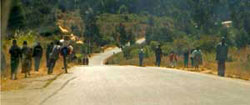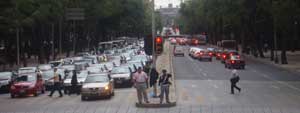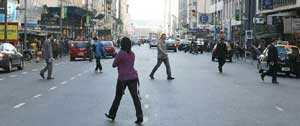Staying Safe on the Road Walking Safely
In many parts of the world, the simplest way to get from point A to point B is on foot. In major cities, walkways and sidewalks make it easy for pedestrians to get around. But once you get past the cities, people who walk from place to place must travel along the roads. Pedestrians must share those roads with every type of vehicle—buses, trucks, cars, motorcycles, bicycles, and even animal-drawn carts.
|
In busy Buenos Aires, Argentina, pedestrians walk between cars, trucks, and bicyclists to get across streets crowded with vehicles. |
The Tanzam Highway is one of the few paved roads in Tanzania, and many people travel it on foot. It is the main road across the country, running from Dar es Salaam to Zambia. |
People often do use crosswalks in their efforts to get across streets. |
Smaller and slower than any vehicle, pedestrians are likely the least visible on the road, especially at night. Because of this, people who travel by foot make up the biggest share of those injured or killed in collisions with vehicles.
The percentage of pedestrians in the total number of traffic fatalities tells the story. For example, the United States has the highest level of daily miles traveled by motorized vehicles, and people famously don't walk very much. However, during the years 2000 to 2005, 11% of traffic fatalities occurred among pedestrians. In Britain, people on foot represented 27% of road fatalities. In parts of the world where more people walk to get around, the statistics are startling. In Africa, in surveys from the late 1990s, the percentages of pedestrian deaths per overall road fatalities were much higher, ranging from 29% in Botswana to 51% in Ethiopia. Pedestrians represent almost 70% of road fatalities in Hong Kong, 65% in India, 50% in South Korea, and 28% in Japan. In China, Malaysia, and Thailand, pedestrian deaths account for a much lower percentage, between 10% and 15% of overall road deaths. In the Middle East, the number is about 50%. By far the largest number of deaths and injuries occur in urbanized areas. And children represent a significant number of pedestrian deaths—35% in India, for example.
So if you have to travel on foot, even a short distance, to visit a friend, go to school, or go to a store, how can you protect yourself on the roads and make that trip safely?
Safety Tips
A pedestrian shares the road with a multitude of vehicles, all of them bigger and all of them faster than a lone person. Basically, the pedestrian must be the one to avoid being involved in a collision.
|
Roadside salespeople run the same risks as pedestrians. They need to be aware of the cars around them. |
Walking between cars on busy roads is a particularly dangerous practice. The pedestrian is moving from unexpected positions, and not as likely to be seen.
|
Foot travelers should try to use sidewalks where possible, to stay far from vehicles. |
It is very important to be as visible as possible. Pedestrians should never, ever assume that that they can be seen by drivers or cyclists. People traveling on foot need to wear bright clothing during the day and a reflective vest or reflective clothing at night, so they can be seen. Carrying a light also helps a walker's visibility.
|
A pedestrian can be as distracted as a driver by a cell phone. Crossing the street while talking on a cell phone is not a safe practice. |
Foot travelers must dress for walking and for the weather conditions. Sturdy shoes and weather-appropriate clothing help maintain a walker's comfort. If the roads are icy, pedestrians must take extra care and walk slowly to prevent falls.
Experienced walkers know to stay off the roadway and as far from the moving traffic as possible. If there is a sidewalk or pathway, pedestrians should use it. However, most roads do not have sidewalks, so people traveling on foot need to stay as far out of traffic as possible. Pedestrians should walk facing traffic, so they can see oncoming vehicles, whether a car or a bicycle. People traveling together should walk single file, rather than side by side, to minimize jutting out into the roadway.
A walker needs be alert and to pay attention to the traffic, with minimal distractions. This means no headphones for music, and no long cell-phone conversations. Pedestrians who need to make cell-phone calls should find a safe place to stop, off the roadway.
|
Photo courtesy of Pablo Ghinaglia Most cities have signal-controlled crosswalks for pedestrians. |
|
|
Photo courtesy of Thania Cardozo Jay-walking, or crossing outside the crosswalks, is an unsafe practice, although very common in many cities. |
|
Periodically, pedestrians need to cross roads to get to where they are going. Many roads have marked pedestrian crossings and traffic signals. It is important for those on foot to cross the road at these locations. The signals and crosswalks are visible, and they are relatively safer for walkers than crossing a road at a random location. In most places motor vehicles and bicycles must stop when a pedestrian steps into a pedestrian crossing. However, many do not. Pedestrians should be alert for drivers and cyclists who do not obey traffic signals or respect crosswalks. Thus walkers must look both ways before crossing a road. If there is a driver approaching, pedestrians need to make sure the driver sees them. One way to do this: make eye contact with the driver and get an acknowledgment that he or she is aware that someone is crossing the road.
Those on foot should act predictably. To the extent that motorists and cyclists are aware of walkers, they expect them to be in certain places. That is why it is so important to cross the road only at corners and established crossing places. Walkers who step out from between parked cars or other objects are not visible until the last minute for motorists and cyclists.
Foot travelers under the influence of drugs or alcohol are the most vulnerable of all. They behave erratically and may fall and injure themselves, or fall into the roadway. In 2006 at least 37% of pedestrian deaths from collisions in the United States were due to pedestrian use of drugs or alcohol. This number is even greater in other parts of the world, where more people get around on foot.
|
|
|
 |
Digging DeeperFind out more about |
|
|
|
This content has been re-published with permission from SEED. Copyright © 2025 Schlumberger Excellence in Education Development (SEED), Inc.










